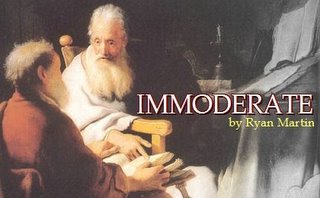A Difficult Christmas text: Matthew 2:15 citing Hosea 11:1 (Part 3)
We have been looking at the diversely interpreted Matthew 2:15 and its use of Hosea 11:1. We began with an introduction and then discussed Calvin's and the sensus plenior views. Today we continue by looking at Robert Gundry's interpretation and the widely held "typological fulfillment" view.
Gundry’s Typology Emphasizing Sonship
Robert Gundry argues that Matthew used Hosea typologically to emphasize Jesus’ divine sonship. He believes that Matthew drew “a multiplicity of parallels”1 between Israel and the life of Jesus, and that Jesus therefore served as the antitype of Israel as Son. He bases this on a number of observations.
First, he argues that εξ Αιγυνπτου should not be translated “Out of Egypt,” but, “Since Egypt,” or “from the time he dwelt there.”2 This shifts the force of the citation from the location of the sojourn to the aspect of “Son.” Second, the clause that the quotation follows speaks of Jesus’ stay in Egypt, not his deliverance from it. Gundry deduces, “Matthew is not highlighting Jesus’ later departure from Egypt as a new Exodus, but God’s preservation of Jesus in Egypt as a sign of his divine sonship.”3 Finally, Matthew emphasizes that it was the Lord who spoke by the prophet, and it is the Lord who claims Jesus as “My Son.”4
The problem with Gundry’s view is that it does not seem plausible that Matthew had no intention to highlight Egypt, because he connects the fulfillment to the immediate context–both vv 14 and 15 mention the sojourn in Egypt, and the text from Hosea likewise speaks of it.
Typological5
This interpretation assumes (as do the previous two) that the meaning of πληροω does not necessarily mean the fulfillment of prophecy, but the “completion or consummation” of the event.6 Therefore, it may not be necessary for the cited text to be a prophecy per se.7 Further, this view, although held by many interpreters, has several variations, and tends to be rather inexact.
In this view, Jesus Christ is a type of Israel, in that they may both be rightly called “God’s Son.” Some also hold that He typifies the “new exodus,” the salvation for the church.8 Proponents point out that Matthew is full of such typology, particularly in the Temptation narrative, which explains why it is so natural for Matthew to implement this kind of understanding of Hosea’s statement.
It is important to realize that this view does not believe that Hosea meant his statement to be a prophecy, and, more importantly, that Matthew was not incorporating Hosea’s authorial intent.9 Thus, the main cause for at least one hesitation with this view is that it so dramatically discounts the literal meaning of the OT author’s original intent. Communication functions on the
ability to use words meaningfully. This view seems to infer that Matthew either did not understand meaning of Hosea’s text, or that he amplified it in order to make his point.10
____________
1Robert Gundry, Matthew: A Commentary on His Handbook for a Mixed Church under Persecution (Grand Rapids: Eerdmans, 1994), 34.
2Gundry, The Use of the OT, 93.
3Gundry, Matthew, 34.
4The Greek renders it thus: ινα πληρωθη το ρηθεν υπο κυριου δια προφητου λεγοντος.
5Representatives of this view (with minor variations) include Carson; Klein, Blomberg, and Hubbard; Plummer; Kaiser; Longenecker; Hendrickson; Craig Keener (A Commentary on the Gospel of Matthew [Grand Rapids: Eerdmans, 1999]); Patrick Fairbairn (The Typology of Scripture [New York: 1900; reprint, Grand Rapids: Baker, 1975]); R. C. H. Lenski (The Interpretation of Matthew [Minneapolis: Augsburg, 1943]); Ed Glasscock ( Matthew: Moody Gospel Commentary [Chicago: Moody, 1997]); Donald Hagner (Matthew 1-13 [WBC 33a; Dallas: Word, 1993]); W. F. Albright and C. S. Mann (Matthew [Anchor 26; New York: Doubleday, 1971]); and R. T. France (“The Formula Quotations of Matthew 2 and the Problem of Communication” New Testament Studies 27 [1981]: 233-51).
6Walter Kaiser, The Uses of the OT, 52. Ed Glasscock says, “The idea of ‘fulfilled’ also does not necessarily need to be taken as implying that every detail must match but rather that the intent of the original message is brought to fruition in the later event” (Matthew, 59).
7Richard Longenecker argues that Matthew implements a pesher interpretation, which means he interprets the OT texts as though they are directly concerned with the interpreter and his community. Matthew, he argues, “is making the point that that which was vital in Israel’s corporate and redemptive experience finds its ultimate and intended focus in the person of Jesus the Messiah” (Biblical Exegesis, 71, 145).
8Tracy L. Howard defended what he calls “Analogical Correspondence” in a 1986 BibSac article (“The Use of Hosea 11:1 in Matthew 2:15: An Alternative Solution” BibSac [1986]). He believes that “the New Testament writer looked back and drew correspondences or analogies with events described in the Old Testament,” and that his approach “considerably reduces the element of subjectivity that the traditional prefigurement view of typology introduces” (320-21). Yet, no matter what he may call it, the fulfillment is viewed typologically.
9“To ask whether Hosea thought of Messiah is the wrong question, akin to using a hacksaw when a scalpel is needed. It is better to say that Hosea, building on existing revelation, grasped the messianic nuances of the ‘son’ language already applied to Israel and David’s promised heir in previous revelation so that had he been able to see Matthew’s use of 11:1, he would not have disapproved, even if messianic nuances were not in his mind when he wrote that verse” Carson, Matthew, 92).
10This writer of this paper rejects this view with a degree of hesitation. Many of the arguments of the typologists have weight, and should not be discarded quite so quickly. For example, types are drawn from several OT events (1 Cor 10:1-5; John 3:14-15; etc). If the NT authors can seemingly tie such events to the life of Christ, why should this hinder Christians from understanding “typological fulfillment” as a means of prophetic fulfillment?
Gundry’s Typology Emphasizing Sonship
Robert Gundry argues that Matthew used Hosea typologically to emphasize Jesus’ divine sonship. He believes that Matthew drew “a multiplicity of parallels”1 between Israel and the life of Jesus, and that Jesus therefore served as the antitype of Israel as Son. He bases this on a number of observations.
First, he argues that εξ Αιγυνπτου should not be translated “Out of Egypt,” but, “Since Egypt,” or “from the time he dwelt there.”2 This shifts the force of the citation from the location of the sojourn to the aspect of “Son.” Second, the clause that the quotation follows speaks of Jesus’ stay in Egypt, not his deliverance from it. Gundry deduces, “Matthew is not highlighting Jesus’ later departure from Egypt as a new Exodus, but God’s preservation of Jesus in Egypt as a sign of his divine sonship.”3 Finally, Matthew emphasizes that it was the Lord who spoke by the prophet, and it is the Lord who claims Jesus as “My Son.”4
The problem with Gundry’s view is that it does not seem plausible that Matthew had no intention to highlight Egypt, because he connects the fulfillment to the immediate context–both vv 14 and 15 mention the sojourn in Egypt, and the text from Hosea likewise speaks of it.
Typological5
This interpretation assumes (as do the previous two) that the meaning of πληροω does not necessarily mean the fulfillment of prophecy, but the “completion or consummation” of the event.6 Therefore, it may not be necessary for the cited text to be a prophecy per se.7 Further, this view, although held by many interpreters, has several variations, and tends to be rather inexact.
In this view, Jesus Christ is a type of Israel, in that they may both be rightly called “God’s Son.” Some also hold that He typifies the “new exodus,” the salvation for the church.8 Proponents point out that Matthew is full of such typology, particularly in the Temptation narrative, which explains why it is so natural for Matthew to implement this kind of understanding of Hosea’s statement.
It is important to realize that this view does not believe that Hosea meant his statement to be a prophecy, and, more importantly, that Matthew was not incorporating Hosea’s authorial intent.9 Thus, the main cause for at least one hesitation with this view is that it so dramatically discounts the literal meaning of the OT author’s original intent. Communication functions on the
ability to use words meaningfully. This view seems to infer that Matthew either did not understand meaning of Hosea’s text, or that he amplified it in order to make his point.10
____________
1Robert Gundry, Matthew: A Commentary on His Handbook for a Mixed Church under Persecution (Grand Rapids: Eerdmans, 1994), 34.
2Gundry, The Use of the OT, 93.
3Gundry, Matthew, 34.
4The Greek renders it thus: ινα πληρωθη το ρηθεν υπο κυριου δια προφητου λεγοντος.
5Representatives of this view (with minor variations) include Carson; Klein, Blomberg, and Hubbard; Plummer; Kaiser; Longenecker; Hendrickson; Craig Keener (A Commentary on the Gospel of Matthew [Grand Rapids: Eerdmans, 1999]); Patrick Fairbairn (The Typology of Scripture [New York: 1900; reprint, Grand Rapids: Baker, 1975]); R. C. H. Lenski (The Interpretation of Matthew [Minneapolis: Augsburg, 1943]); Ed Glasscock ( Matthew: Moody Gospel Commentary [Chicago: Moody, 1997]); Donald Hagner (Matthew 1-13 [WBC 33a; Dallas: Word, 1993]); W. F. Albright and C. S. Mann (Matthew [Anchor 26; New York: Doubleday, 1971]); and R. T. France (“The Formula Quotations of Matthew 2 and the Problem of Communication” New Testament Studies 27 [1981]: 233-51).
6Walter Kaiser, The Uses of the OT, 52. Ed Glasscock says, “The idea of ‘fulfilled’ also does not necessarily need to be taken as implying that every detail must match but rather that the intent of the original message is brought to fruition in the later event” (Matthew, 59).
7Richard Longenecker argues that Matthew implements a pesher interpretation, which means he interprets the OT texts as though they are directly concerned with the interpreter and his community. Matthew, he argues, “is making the point that that which was vital in Israel’s corporate and redemptive experience finds its ultimate and intended focus in the person of Jesus the Messiah” (Biblical Exegesis, 71, 145).
8Tracy L. Howard defended what he calls “Analogical Correspondence” in a 1986 BibSac article (“The Use of Hosea 11:1 in Matthew 2:15: An Alternative Solution” BibSac [1986]). He believes that “the New Testament writer looked back and drew correspondences or analogies with events described in the Old Testament,” and that his approach “considerably reduces the element of subjectivity that the traditional prefigurement view of typology introduces” (320-21). Yet, no matter what he may call it, the fulfillment is viewed typologically.
9“To ask whether Hosea thought of Messiah is the wrong question, akin to using a hacksaw when a scalpel is needed. It is better to say that Hosea, building on existing revelation, grasped the messianic nuances of the ‘son’ language already applied to Israel and David’s promised heir in previous revelation so that had he been able to see Matthew’s use of 11:1, he would not have disapproved, even if messianic nuances were not in his mind when he wrote that verse” Carson, Matthew, 92).
10This writer of this paper rejects this view with a degree of hesitation. Many of the arguments of the typologists have weight, and should not be discarded quite so quickly. For example, types are drawn from several OT events (1 Cor 10:1-5; John 3:14-15; etc). If the NT authors can seemingly tie such events to the life of Christ, why should this hinder Christians from understanding “typological fulfillment” as a means of prophetic fulfillment?





0 Comments:
Post a Comment
<< Home